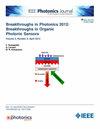Self-Denoising of BOTDA Using Deep Convolutional Neural Networks
IF 2.1
4区 工程技术
Q3 ENGINEERING, ELECTRICAL & ELECTRONIC
引用次数: 0
Abstract
We propose the self-denoising network (SDNet), a self-supervised network based on a convolutional neural network (CNN), for Brillouin trace denoising. With the target noisy image as the only input, the proposed method has no hardware restriction, requirement for image priors, or assumption for noise distribution. The Bernoulli mask and the partial convolutional layer implemented in the encoding process help capture the input features efficiently, while the dropout in the decoding process extends the feasibility and generality of the proposed network. Experimental results indicate that for Brillouin traces with frequency steps of 0.5 MHz/1 MHz, the proposed SDNet can improve the accuracy of Brillouin frequency shift (BFS) estimation by 40%/61%, 32%/31% and 24%/32% under input signal-to-noise ratios (SNR) of 5.5 dB, 8.5 dB, and 11.5 dB, respectively, without degradation in spatial resolution. Furthermore, the SDNet demonstrates a robust denoising performance in BOTDA systems with different application scenarios.基于深度卷积神经网络的BOTDA自去噪
我们提出了自去噪网络(SDNet),一种基于卷积神经网络(CNN)的自监督网络,用于布里渊迹去噪。该方法以目标噪声图像为唯一输入,不受硬件限制,不需要图像先验,不需要对噪声分布进行假设。编码过程中实现的伯努利掩码和部分卷积层有助于有效捕获输入特征,而解码过程中的dropout扩展了所提出网络的可行性和通用性。实验结果表明,对于频率阶跃为0.5 MHz/1 MHz的布里渊走线,在输入信噪比分别为5.5 dB、8.5 dB和11.5 dB的情况下,SDNet可将布里渊频移(BFS)估计精度分别提高40%/61%、32%/31%和24%/32%,且空间分辨率不降低。此外,SDNet在不同应用场景下的BOTDA系统中表现出稳健的去噪性能。
本文章由计算机程序翻译,如有差异,请以英文原文为准。
求助全文
约1分钟内获得全文
求助全文
来源期刊

IEEE Photonics Journal
ENGINEERING, ELECTRICAL & ELECTRONIC-OPTICS
CiteScore
4.50
自引率
8.30%
发文量
489
审稿时长
1.4 months
期刊介绍:
Breakthroughs in the generation of light and in its control and utilization have given rise to the field of Photonics, a rapidly expanding area of science and technology with major technological and economic impact. Photonics integrates quantum electronics and optics to accelerate progress in the generation of novel photon sources and in their utilization in emerging applications at the micro and nano scales spanning from the far-infrared/THz to the x-ray region of the electromagnetic spectrum. IEEE Photonics Journal is an online-only journal dedicated to the rapid disclosure of top-quality peer-reviewed research at the forefront of all areas of photonics. Contributions addressing issues ranging from fundamental understanding to emerging technologies and applications are within the scope of the Journal. The Journal includes topics in: Photon sources from far infrared to X-rays, Photonics materials and engineered photonic structures, Integrated optics and optoelectronic, Ultrafast, attosecond, high field and short wavelength photonics, Biophotonics, including DNA photonics, Nanophotonics, Magnetophotonics, Fundamentals of light propagation and interaction; nonlinear effects, Optical data storage, Fiber optics and optical communications devices, systems, and technologies, Micro Opto Electro Mechanical Systems (MOEMS), Microwave photonics, Optical Sensors.
 求助内容:
求助内容: 应助结果提醒方式:
应助结果提醒方式:


